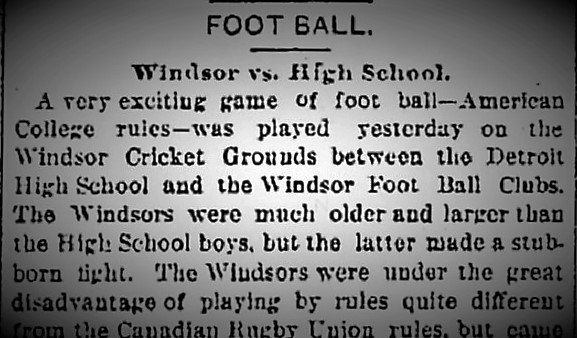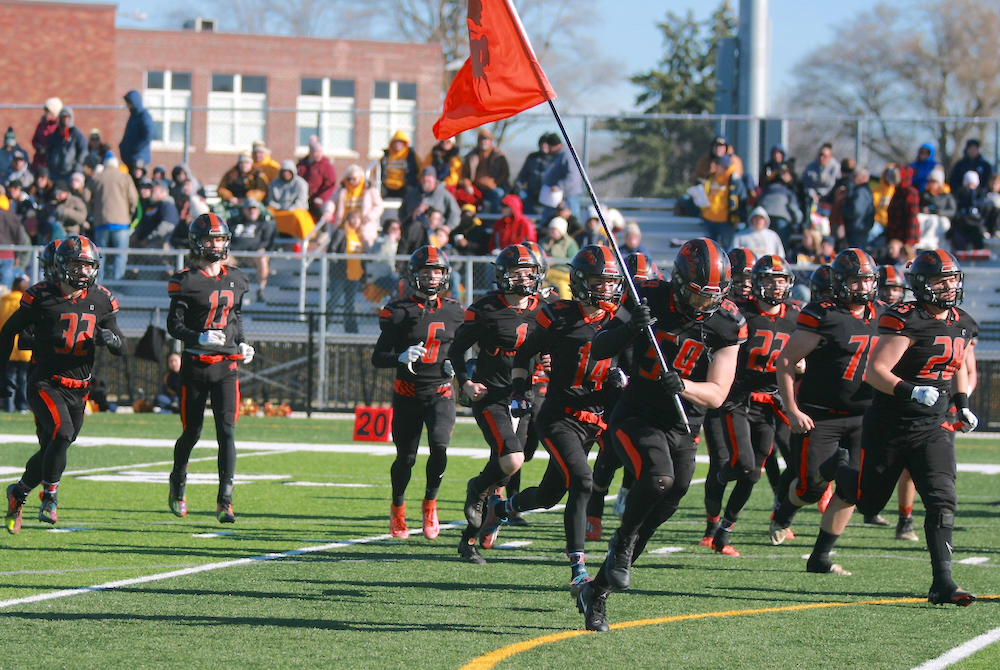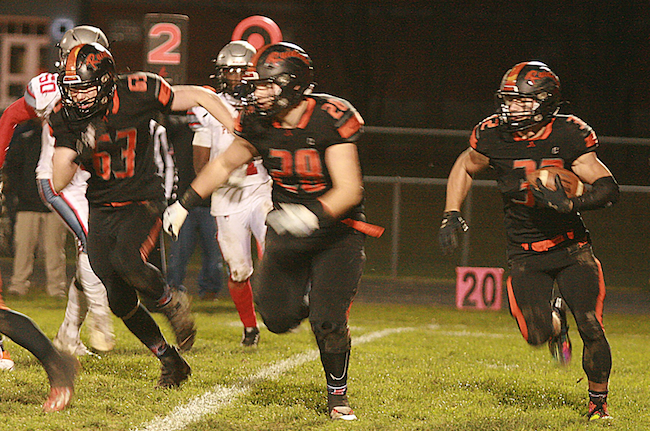
Football Kicks Off Again, 129 Years Later
August 25, 2017
By Ron Pesch
Special for Second Half
Buried in the text on the fourth page of the Saturday, October 27, 1888, Detroit Free Press is a single, concise sentence bearing a minimum amount of detail.
“The Windsor foot ball team will play the Detroit High School team this afternoon at 3.”
To date, this is the earliest account of a Michigan high school playing the game of “foot ball.”
The following day’s paper provides only a few more details. The game was played on the Windsor Cricket Grounds. Despite the great disadvantage of playing under “American Football rules … quite different from the Canadian Rugby Union rules …” the “older and larger” Windsors won the contest, 12-6. Rosters for each squad were provided.
 Under American rules of the time, a touchdown was worth four points, with a conversion kick following a touchdown worth two additional points. At the time, a field goal counted for five points and a safety was worth two. The teams, however, may have agreed to a different scoring system before the contest.
Under American rules of the time, a touchdown was worth four points, with a conversion kick following a touchdown worth two additional points. At the time, a field goal counted for five points and a safety was worth two. The teams, however, may have agreed to a different scoring system before the contest.
Was this the first football game for a Michigan high school? That’s unlikely, but it is certainly among the earliest published accounts involving a prep game in the state.
It’s a fair assumption that foot ball, or some version of the game, was being played in neighborhoods before that time, at least based on the following statement found in the Jackson Citizen Patriot, dated June 18, 1867. Only days before, Dorrance & Goodwin’s, a store on Main Street in Jackson, had placed advertisements in the newspaper’s classifieds noting the pending arrival of this new product.
“Foot Ball – The pastime was inaugurated on our streets yesterday. Three or four balls were kept in motion all day on Main street alone. It affords no little amusement to the little boys, and is certainly a healthy exercise for the larger ones. It’s all right as long as no windows are broken or horses scared. Both calamities were barely escaped scores of times during the day.”
Rutgers and Princeton are credited with playing the first college football game in 1869. A decade later, in 1879, the University of Michigan established a football team.
Detroit High School played a number of games in 1888, besides the Windsor match, including a contest with the Tappen School from the Corktown area of Detroit. Played at the Detroit Athletic Club grounds on the afternoon of Thursday November 15, a final score was not mentioned in the following day’s Free Press.
For those unfamiliar with the sport, an account of the University of Michigan versus Detroit Athletic Club contest that appeared in the November 18 Free Press served as a fine introduction to the game, and the determination behind securing “possession of a leather-covered foot ball.”
“It was very interesting to see one speedy young man, after a desperate struggle in which the spectators fully expected to see him lose an arm or a leg, get away from his captors and start like a deer, with eight or ten of the opposite side in full pursuit. He is overtaken and the leader of the pursuing party springs upon the back of the man with the inflated trophy, bearing him to the ground with a dull thud … It is also an inspiring sight to see a fleet-footed player seize the ball and run at full speed in the direction of the goal of his opponents. Then a wing-footed opponent cuts across to intercept him, makes a flying leap, grasps the fugitive around the neck or waist and both go to grass with a suddenness and velocity that transforms them into human wheels …
 “While one unaccustomed to foot ball will naturally be startled by some of the acrobatic feats, still it is impossible to watch the game for any length of time without a tingling of the blood and holding of the breath. It is most intensely exciting, continuous in action and replete with fine points of play.
“While one unaccustomed to foot ball will naturally be startled by some of the acrobatic feats, still it is impossible to watch the game for any length of time without a tingling of the blood and holding of the breath. It is most intensely exciting, continuous in action and replete with fine points of play.
“It may be explained that the goals in a foot ball game are set at a distance of 330 feet from each other. The goal is made by placing two pieces of scantling twenty feet long upright in the ground, eighteen and one-half feet apart. Another piece runs midway horizontally between the uprights, and the ball must go over the horizontal piece and between the uprights to count a goal. There are eleven men on each side and the object is, of course, to get the ball through the goal of the other. The time of game is an hour and a half each side playing forty-five minutes from each goal, with an intermission of ten minutes between halves.”
A player who ran over an opponent’s goal line, “with the ball and touched it down” was then entitled to “bring the ball in front of the goal and attempt to kick it through”…
Among those playing for the Athletic Club squad that day was “little Hugh Brooks (captain) of the high school team.” Eligibility rules for players would evolve over time.
On Saturday, November 24, Detroit High School squared off for the first of two contests with Ann Arbor High School, this one at the Detroit Athletic Club grounds. Admission to the 2:45 p.m. contests was 25 cents. A crowd of around 300 watched “an exciting illustration of how Rugby foot ball is played. The exhibition by the Ann Arbor boys was considerably better than that of the Detroiters,” noted the Free Press, “the result of that being that Detroit’s banners have been kicked into the dust.”
Ann Arbor returned home with a 12-0 victory.
A second game with Ann Arbor was quickly scheduled.
In between, on Thursday, November 29, the Detroit High School squad played the Athletic Club before a crowd of about 200.
 “While the Athletics won by 12 to 0, still their playing was very loose, probably the result of over confidence. The Athletics will have to rid themselves of this by Saturday or the Albions will make short work of them.”
“While the Athletics won by 12 to 0, still their playing was very loose, probably the result of over confidence. The Athletics will have to rid themselves of this by Saturday or the Albions will make short work of them.”
A large crowd gathered in the drizzling rain in Ann Arbor on Saturday, December 8, for what appears to be the final contest of the 1888 season for the high school teams of Detroit and Ann Arbor.
“It was a fine game. (Captain) Brooks, McGraw and Wisner, for Detroit, and Jewett, Diggert, Dupont, and Rathbone for Ann Arbor, made fine plays for their respective sides.” The result was an 8 to 2 win, and redemption, for the Detroit squad.
Today, 129 years later, “football” has seen wild expansion, numerous rule changes, and huge advancement in equipment worn when compared to those pioneer days of the sport. In 2017, more than 1 million individuals will suit up for high school teams across the United States. In Michigan alone, more than 36,000 participate in prep football.
And our state’s original programs live on. On Friday, Detroit Central opened its season with a win over Detroit Loyola. Ann Arbor High School, renamed Ann Arbor Pioneer in the late 1960s, fell in its Friday opener to Muskegon.
Welcome to another season of America’s favorite pastime.
 Ron Pesch has taken an active role in researching the history of MHSAA events since 1985 and began writing for MHSAA Finals programs in 1986, adding additional features and "flashbacks" in 1992. He inherited the title of MHSAA historian from the late Dick Kishpaugh following the 1993-94 school year, and resides in Muskegon. Contact him at [email protected] with ideas for historical articles.
Ron Pesch has taken an active role in researching the history of MHSAA events since 1985 and began writing for MHSAA Finals programs in 1986, adding additional features and "flashbacks" in 1992. He inherited the title of MHSAA historian from the late Dick Kishpaugh following the 1993-94 school year, and resides in Muskegon. Contact him at [email protected] with ideas for historical articles.
PHOTOS: (Top) The Detroit Free Press included brief coverage of the first "reported" game on Oct. 28, 1888. (Middle) When Michigan’s state government moved from Detroit to Lansing in 1847, the old Capitol building was re-opened as the Detroit’s first city high school in 1863. To better accommodate Detroit’s growing population, the old two-story structure was remodeled into a four-story building, unrecognizable to most. The school served the city well until January 1893, when it burned to the ground. (Below) Erected in 1856 at the cost of $27,000, Ann Arbor High School at State and Huron (now site of the North Quad of the University of Michigan) was destroyed by fire in 1904. (Photos courtesy of Ron Pesch.)

'Next Person Up' Mentality, Super Subs' Success Has Almont Returning to Ford Field
By
Paul Costanzo
Special for MHSAA.com
November 24, 2023
Gavin Szymansksi was nervous for about two plays.
 The junior was making his first start for the Almont football team in Week 3 against Imlay City, replacing injured Cole Willard at left tackle.
The junior was making his first start for the Almont football team in Week 3 against Imlay City, replacing injured Cole Willard at left tackle.
Willard had been hurt in the first half of the Raiders’ Week 2 game against Algonac, and while Szymanski had filled in then, there was less pressure, as his team already had a hefty cushion.
But this was different. A first varsity start, on the opposite side of the line from his more familiar right tackle position.
“It wasn’t too scary in that moment (against Algonac), plus I thought he was going to be back,” Szymanski said. “(Week 3) was kind of scary. But the team was pretty supportive, and they didn’t have any doubt I’d be able to fill in. Then we had a TD on like the first or second play in the Imlay game, and I was fine.”
Szymanski filled in seamlessly for the Raiders, which became a theme throughout the season. As players went down with injuries, both short and longterm, their backups filled in without a hitch.
While every team is banged up throughout a season, for a Division 6 school with just more than 30 players on the varsity roster, it’s a remarkable feat to remain competitive, let alone go 8-1 during the regular season, win the Blue Water Area Conference title, and, for the second time in school history, advance to the MHSAA Finals at Ford Field.
“Our motto is ‘next person up,’” Almont coach James Leusby said. “They literally live by that. You never know when your number is going to get called, but they seem to always be ready.”
Szymanski – who is back in the starting lineup for the Raiders, now as a right tackle filling in for the injured Yousif Abu-Joudeh – and his Almont teammates will play Kingsley at 4:30 p.m. Saturday in the Division 6 Final, looking for the program’s first Finals title.
While the Raiders certainly have star power – junior back Chase Battani had rushed for 1,169 yards and 18 touchdowns – it’s been the efforts of a team that has stretched well beyond it’s starting 22 that put them in this position.
The list of injuries, big and small, is extensive.
 It started with Willard and ended with Abu-Joudeh, who was injured in Week 9. Fullback Jacob Stewart, who was averaging 15 yards per carry, was injured in Week 6 and missed a stretch. Matthew Bacholzky stepped up in his place, along with Ayden Ferqueron.
It started with Willard and ended with Abu-Joudeh, who was injured in Week 9. Fullback Jacob Stewart, who was averaging 15 yards per carry, was injured in Week 6 and missed a stretch. Matthew Bacholzky stepped up in his place, along with Ayden Ferqueron.
Outside linebacker Eric Haddon suffered a high ankle sprain, and was replaced by Jacob Fuller, who had spent most of the season on the offensive side of the ball. Defensive end and tight end Brent Corneau missed a stretch as well, and Nolan Maxlow, who was a split end and defensive back, had to step up in his place.
And that’s just what Leusby could remember off the top of his head late Tuesday night.
“In Division 6, you don’t have much depth, so the backups have to know multiple positions,” Leusby said. “I think it talks highly of our program and our system and the coaches we have in it. In the playoffs, we’ve started two JV kids at defensive tackle. Our motto is, when we bring our sophomores up, the best kids are going to play.”
Because of that program-wide preparation, players are not only ready, but have confidence in one another when it’s someone else’s time to step up.
“I felt confident in him,” Willard said of Szymanski. “A lot of kids get a lot of reps at practice. And we’ve run the same plays for like five years, so everyone knows them.”
Leusby, who took over at Almont in 2015, credited not just his high school staff, but a youth program that’s bursting at the seams with participants.
Almont is a football community, and while there are no Finals titles listed on the city limits sign, it has a very proud history of success, especially lately.
The Raiders have made the postseason each of the past 14 seasons, and 17 of the past 18. The lone miss was 2009, when they were 5-4. Only the pandemic-shortened 2020 season resulted in a record that wasn’t over .500, and even that one ended at 3-3 with a playoff win.
“I think, all in all, the community, they invest a lot of time into the program, and they expect results,” Leusby said. “You ask anybody, Almont is a football town.”
Leusby and his players are expecting that support to result in a lot of orange and black in the lower bowl of Ford Field on Saturday.
“Everybody has our back and wants us to win,” Willard said. “The whole town is travelling down there.”
They did the same in 2019 when the Raiders made their previous run to Ford Field. That ended with a 31-17 loss to Grand Rapids Catholic Central in the Division 5 Final.
“Honestly, when I was there in 2019, I was just thrilled to get to Ford Field,” Leusby said. “Yeah, it was a game and we wanted to win, but it was just cool to get to the Finals. After it was over, I thought, maybe I had sent the wrong messages. This year, we’ve reiterated that we’re going there to come home with the big daddy. Not second place – we want the big trophy.”
 Paul Costanzo served as a sportswriter at The Port Huron Times Herald from 2006-15, including three years as lead sportswriter, and prior to that as sports editor at the Hillsdale Daily News from 2005-06. He can be reached at [email protected] with story ideas for Genesee, Lapeer, St. Clair, Sanilac, Huron, Tuscola, Saginaw, Bay, Arenac, Midland and Gladwin counties.
Paul Costanzo served as a sportswriter at The Port Huron Times Herald from 2006-15, including three years as lead sportswriter, and prior to that as sports editor at the Hillsdale Daily News from 2005-06. He can be reached at [email protected] with story ideas for Genesee, Lapeer, St. Clair, Sanilac, Huron, Tuscola, Saginaw, Bay, Arenac, Midland and Gladwin counties.
PHOTOS (Top) Senior Isaiah Bankston (59) leads Almont onto the field before last Saturday’s Semifinal win over Ovid-Elsie. (Middle) Chase Battani (32) followers his Raiders blockers during the Regional Final win over Detroit Edison. (Photos by Maureen Flannery Walton.)

